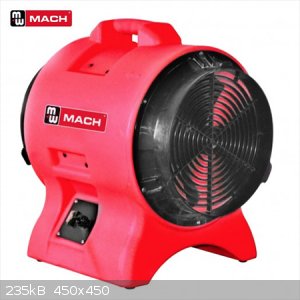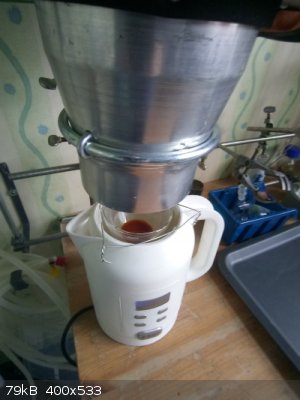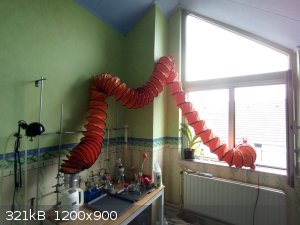ScienceBum
Harmless

Posts: 22
Registered: 15-9-2014
Location: Florida/California/Arizona
Member Is Offline
Mood: decoherenced
|
|
Safe Fume Production Practices
Today I attempted a trial by fire scenario in terms of safely handling fume production. There were a few labs I want to do which required either the
use of nitric acid, or nitrating some compound to some degree. The problem with that is I don't have a fume hood, or any closed or sealed environment
to handle my reactions in. This severely limits my ability to perform certain reactions which have a heavy fume production rate (as an example, you
can watch any copper penny + nitric acid reaction to see the ridiculous amount of toxic fumes produced).
So to see if I could safely do any of these reactions with my current setup, I attempted two things.
First: to see if I could use a very dilute nitric acid solution to dissolve a penny into.
Without doing the stoichiometry since I was working with such a small scale, i weighed out about 5 grams of Potassium Nitrate and dissolved that in
about 100 mL of water. To that I added about 10mL of concentrated Sulfuric Acid.
https://i.ibb.co/1JW4Sqs/1.jpg
The addition of the acid boiled off a bit of the water which was to be expected, but other than that there was no visual change apart from some slight
bubbling. To this solution I added a penny and there was essentially no reaction at room temperature. No fuming even with agitation, no visible
external reactions to the penny. It seems the solution was too dilute and/or cold to do anything.
https://i.ibb.co/nRfG0Cf/2.jpg
Since working with such a dilute solution would obviously take far too long to be of any use, I moved onto the next attempt, seeing if my ventilation
setup could handle a high fume production rate on a small scale.
I placed a carbon filter extraction fan and a normal box fan facing each other on my work area with the reaction space in between as close as I could
get everything. The objective now was to see if my extraction fan could handle the nitric acid fumes well enough in an open environment to the point
where I couldn't notice anything.
Instead of diluting the KNO3 like before, this time I poured the acid directly onto the nitrate salt.
https://i.ibb.co/6vbqK0p/3.jpg
There was no reaction initially, but after some agitation it quickly became cloudy, and eventually all of the nitrate had reacted. I noticed a little
visible fuming when the mixture was agitated, but nothing apart from that.
I then added the penny into the beaker, and like usual at first there was no immediate visible reaction at room temperature. After agitation there was
some slight bubbling and slight fume production. The fumes were white, and even though my fans seemed to do an excellent job handling them, I started
to notice a very slight chlorine-ish smell. This was the first sign of problems.
https://i.ibb.co/gWwbh5C/5.jpg
Thankfully things did not get worse at this point at room temperature. Fumes were only produced if i agitated the beaker, otherwise there was no fume
production, and it seemed like I could handle that rate. The problem at this point though was that the reaction simply did not progress at all. There
was some slight constant bubbling, but nowhere near fast enough to be useful. The penny was still essentially undamaged.
Now the only thing left for me to try was heating up the beaker with the penny to see if that would speed up the reaction rate. After slowly heating,
fume production began in earnest without agitation. The fumes maintained it's white color the entire time, which leads me to believe this was nitric
acid vapor and not any of the nitrogen oxide gases typically associated with these kinds of reactions.
Unfortunately, even though visually I could see the fumes being dealt with by my extraction fan, at this point I noticed singing sensations across the
more sensitive areas of my skin and face, and my throat especially. The semi chlorine-like smell persisted. Heating was turned off and the beaker was
allowed to cool to room temperature. After cooling, the unreacted KNO3 appeared to crystallize out of solution. All reaction vessels and items that
came into contact with the acids were washed with copious amounts of water.
Conclusion
I can safely assert that even working on a small scale, I cannot in my mind safely deal with high toxic or corrosive fume production rates in my work
area. Even though the stinging sensations were nowhere near as bad as some other times I accidentally gassed myself, I still felt too uncomfortable
with the results of my experiment to try again.
Perhaps it was obvious to most others, but it seems like there really is no substitute for a good enclosed space with proper ventilation like a
fumehood to deal with these sorts of things. I was really hoping I'd be able to mitigate the risk factors associated with working with nitric acid,
but right now that's just not feasible for me.
If any of you have been able to deal with nitric acid fumes before, like through some nifty scrubbing techniques or better ventilation setups that
don't require a fumehood, let me know!
-Cap'n Rum the Science Bum
|
|
|
Antigua
Hazard to Others
  
Posts: 155
Registered: 27-9-2020
Member Is Offline
|
|
Just use a regular scrubber or even a tube inserted into a stopcock and an inverted funnel... NO2 will dissolve pretty much quantitatively into a
dilute NaOH solution.
|
|
|
Morue
Harmless

Posts: 11
Registered: 3-4-2020
Location: Canada
Member Is Offline
|
|
Some fumes are harder to handle than others. NOx fumes are manageable though, as long a you use a proper trap to avoid releasing a bunch of it into
the atmosphere (which is not a good practice anyway, even if you use a fumehood). For sulfurous gases, trap as much as you can and/or use a gas mask
with cartriges that are specifically designed for sulfurous gases. Same applies for halogens or other acidic fumes. Be extra careful with carbon
monoxide. You can't smell it, it's cannot be easily trapped and it's extremely poisonous. You can buy however a CO detector in order to detect it's
presence.
Also, you can just put a small flag on your workbench outside! This gives you an indication of the direction of the wind, and also if the wind
direction changes during an experiment.
I don't have a fumehood and I do all my experiments outside and everything has been ok for now.
|
|
|
teodor
National Hazard
   
Posts: 876
Registered: 28-6-2019
Location: Heerenveen
Member Is Offline
|
|
NO2 fumes could be easily vented out with a construction fan like this. You can put it on a window, it makes blow which is strong enough , just keep a
beaker close. NO2 has a good visibility so you can control the process well. Also you can attach a hose and get fumes from any point of your room but
with less power.
Better to do it in a rainy day, the rain will absorb NO2.

|
|
|
Cou
National Hazard
   
Posts: 958
Registered: 16-5-2013
Member Is Offline
Mood: Mad Scientist
|
|
Did you work outside?
|
|
|
teodor
National Hazard
   
Posts: 876
Registered: 28-6-2019
Location: Heerenveen
Member Is Offline
|
|
Also, if you have no good ventilation, a water pump is very well works for sucking the fumes off and mixing it with water, just work in a closed flask
with a silicone hose attached. And use some flask between the pump and the reaction flask, for preventing sucking of water back. You can put your
scrubber there.
Working outside doesn't solve problem of managing fumes, you and your neighbours still will be able to breath them if you didn't manage the safety
properly. I got more issues with toxic fumes (breathing them) when was working outside than when was working inside, also because inside I have more
instruments readily available.
[Edited on 1-10-2020 by teodor]
But I am not sure that silicone is good enough to resist NO2, so doing it with pump is more complex. You will need at least PTFE or something like
between your flask and the scrubber.
[Edited on 1-10-2020 by teodor]
[Edited on 1-10-2020 by teodor]
|
|
|
Swinfi2
Hazard to Others
  
Posts: 131
Registered: 19-2-2018
Location: England
Member Is Offline
Mood: Catalytic
|
|
Your penny dissolving requires a small amount of water to dissolve the copper nitrate else it forms a passive layer.
But not too much to kill the concentration.
I'd advise a fair amount of caution as it's pretty violent even without heating. Outside/upwind or fume hood make sure you look after your lungs as
you don't get any retrys.
|
|
|
Fyndium
International Hazard
    
Posts: 1192
Registered: 12-7-2020
Location: Not in USA
Member Is Offline
|
|
I would personally never perform any reactions in an open flask that could be done in a closed apparatus. This allows for almost perfect vapor and
odor control by allowing the use of condenser and various scrubbing methods, including chemical neutralization, aspirating the fumes down the drain,
or just simply leading a long tube outdoors for the fumes to dissipate safely.
Activated carbon filters are only viable method for ventilation for many that work indoors without structured ventilation. Carbon is not good at
filtering many smaller molecules and stuff like ammonia and probably nitrogenous oxides also goes straight through.
|
|
|
teodor
National Hazard
   
Posts: 876
Registered: 28-6-2019
Location: Heerenveen
Member Is Offline
|
|
I think it could be relevant here. It is my N+1 attempt to get Fe(NO3)3 * 9H2O crystallised. Now I try to evaporate it from acidic (HNO3) solution on
a water bath. So, I use the construction fan to get the fumes out. The end side is self-made from standard ventilation parts from a hardware store.


|
|
|
teodor
National Hazard
   
Posts: 876
Registered: 28-6-2019
Location: Heerenveen
Member Is Offline
|
|
This is more close look onto the construction of the end piece.
On the weekend I've made some amount of PbO2 (from PbCl2) and washed it with nitric acid. I decided to use the acid waste to make some Sr(NO3)2. The
problem with a pottery grade strontium carbonate which I used is that it contains some considerable amount of SrS and possible phosphide, not sure
about that but the smell is terrible and not only H2S. Last time I was sick a few days after working with BaCO3 of the same quality. I hoped HNO3 will
oxidise these nasty gases to S etc, but it was not the case - at least not completely, probably it depends on dilution and it was less than 3M in my
case. So, I pulled the ventilation pipe and was able to continue. After this it was no smell in the room at all. The only problem is a funnel, I have
to bind it with a piece of wire to prevent it to get sucked - the blow is quite strong.

[Edited on 5-10-2020 by teodor]
|
|
|